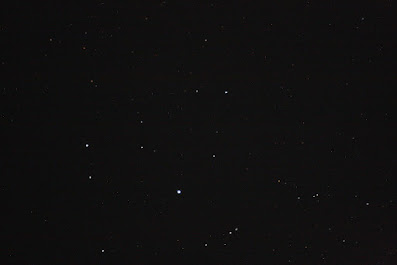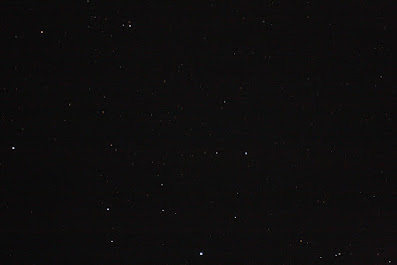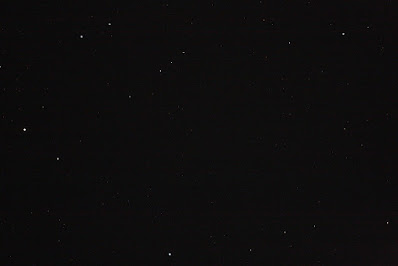Identified the images from the Friday night double star run. All times Friday late-night and early Saturday morning. All images RAW, daylight white balance, ISO 3200, 20 seconds. Darks not applied, so lots of hot pixels.
HD 182570 imaged at 23:47.
HD 183013 captured at 23:52. It's the bright star below centre in the image below.
[ed: Did in fact capture the area,
wide-field, with the MRO refractor a few nights before.]
HD 183013 at 12:56 AM. It's near the bottom edge of the frame below.
TYC 2138-183-1 imaged at 1:02.
HD 184173 photographed at 1:04.
Caught tight double COU 516 at the far west edge of the image. Too tight at 1.8" to split.
GSC 1613-636 photographed at 1:08.
TYC 1613-269-1 imaged at 1:09.
The top of the backwards L, on the west side of the image, that's double HD 344494 aka A 161. Whoa, with a sep of 0.20", it is definitely not splittable.
TYC 1613-569-1 imaged at 1:14.
GSC 2125-1477 photographed at 1:16.
GSC 1612-1177 imaged at 1:18.
HD 344319 is at the top of the bent line of stars at the right or west. That's TDT 1453 with an impossible sep of 0.60".
HD 344413 imaged at 1:21.
TYC 1612-761-1 imaged at 1:22.
TYC 1612-571-1 imaged at 1:26.
Fantastic stuff here!
OK, left of centre, stlightly east, there's that isosceles triangle. The bright northern apex is double star HD 183014 aka STF 2523. A simple double with two equally bright stars, white to the north, pale yellow to the south. They look to be at a 45° angle compared to the image frame (but that's off by about 10 degrees). So the position angle is around 135? Plus or minus 10? Very close, touching, a snowman shape. ST3P says they are magnitudes 7.4 and 8.2 at a separation of 6.5". PA is 148°!
[ed: Oh. Look at that. I observed HD 183014/Struve 2523 in the past... Evening of
8 Aug '14.]
The bottom apex is double star HD 183058 or KRU 8. I just love the dim companion to the south-east. Maybe again 135—no, 145! Blue-white and pale orange. Many magnitudes different. ST3P Object Information says: mags 7.1 and 14.2, PA 135°, sep 7.0". Sweet.
The dim star at the mid-point apex is a double. But not splittable at 0.4". That's HD 344434 or A 2786.
There's an orange star a bit north of centre. WW Vul or LI 2. SkyTools says the B element is mag 16 so I don't think I'm getting that.
[ed: This is a little hard to see but there's a wide pair at a 45 degree just right of centre. Part of a triangle with a very faint object at the right or west. That's the double star KPP 439. ST3P thinks this is a single star called GSC 01612-0336. Very faint, oriented roughly east-west. Tight. The image quality is poor so it makes the two stars touch.]
[ed: Oh. Just learned that HLM 23 is the double of medium faint stars south-east of the lower triangle apex. I thought that was KRU... A is brighter, to the south-west; B is about 1 mag dimmer and to the north-east. Both are white. SkyTools calls the bright star TYC 01612-0316 1.]
TYC 1612-205-1 imaged at 1:28.
PPM 108934 captured at 1:30.
There's an obvious pair at the left (east) with equally bright pale orange and blue stars. Nearly perfectly west and east. That's WSI 22. I visually spotted them a couple of nights back.
The bright unequal touching pair is HD 182570 aka Struve 2515. A is white, B is pale orange. It's actually a triple. The B companion is the bright one merged with A. I believe C is visible, well away, due south, a dim orange.
TDT 1421 photographed at 1:33.
TDT 1421 is a very tight double with a faint companion, 1.0" separation. It's the dim star slightly right of centre. I cannot split it in the photo. The medium bright star toward the south-east is TDS 990. It's 1.1". So, again, no split happening.
At the far east edge of the image we have HD 344338. STF 3111 is a 2.5" double. It is rod shaped in the image. I think that's legit as the rest of the field shows round stars. But certainly they are indistinguishable.
Collected photons for HD 182421 at 1:36.
This image encompasses double HD 344315 also referred to as TDT 1416. Not split at 0.7".
Interesting that last shot. It has an orange cast. The light pollution from Newmarket bouncing off the incoming clouds?
Most were manually identified. Astrometry.net helped with one or two images.
§
Oops. Forgot to include for review the image with NGC 6793.

This is centred near the bright star HD 344322.
The brightest star, heading east, is HD 182695. The double, aka COU 513, is not splittable at 0.2".
Now, finally, within the small open cluster, toward the north, there is the obvious close double. HJ 886. They seem to be equal in colour to me and about 1 magnitude different. The PA is just a few degrees from north, 5 or 10? ST3P OI says: 10.4 and 11.5, PA 47°, sep 9.3".
[ed: Dove into the WDS. The equally bright stars south of HJ 886 are now considered the C and D stars, SLE 939 AC and SLE 939 AD specifically. Cool! C is roughly south and D is south-east. C is about 5 or 6 times the AB split and D is a bit less than double C.]
[ed: With a nudge from the WDS, spotted the tight double north-east from the 886, inline actually. Very tight, black line, with B about two magnitudes dimmer and to the south, maybe about a PA of 200. That's SLE 940.]
[ed: Bottom-left quadrant of the image is a faint pair, A to the south-east. Touch wider than 886. Oriented around 310 degrees PA. They are a bit dimmer than 886. That's SLE 942. SkyTools calls this TYC 01612-1393 1.]





















No comments:
Post a Comment